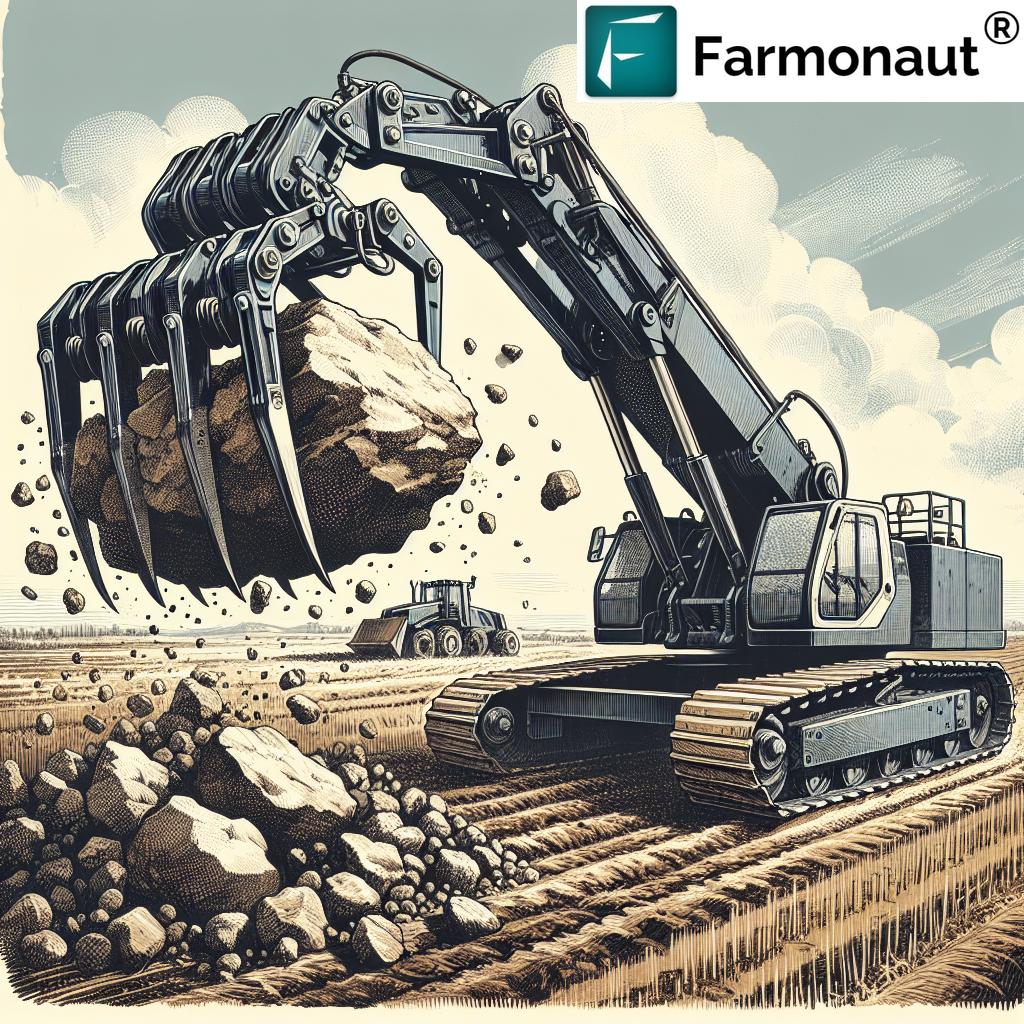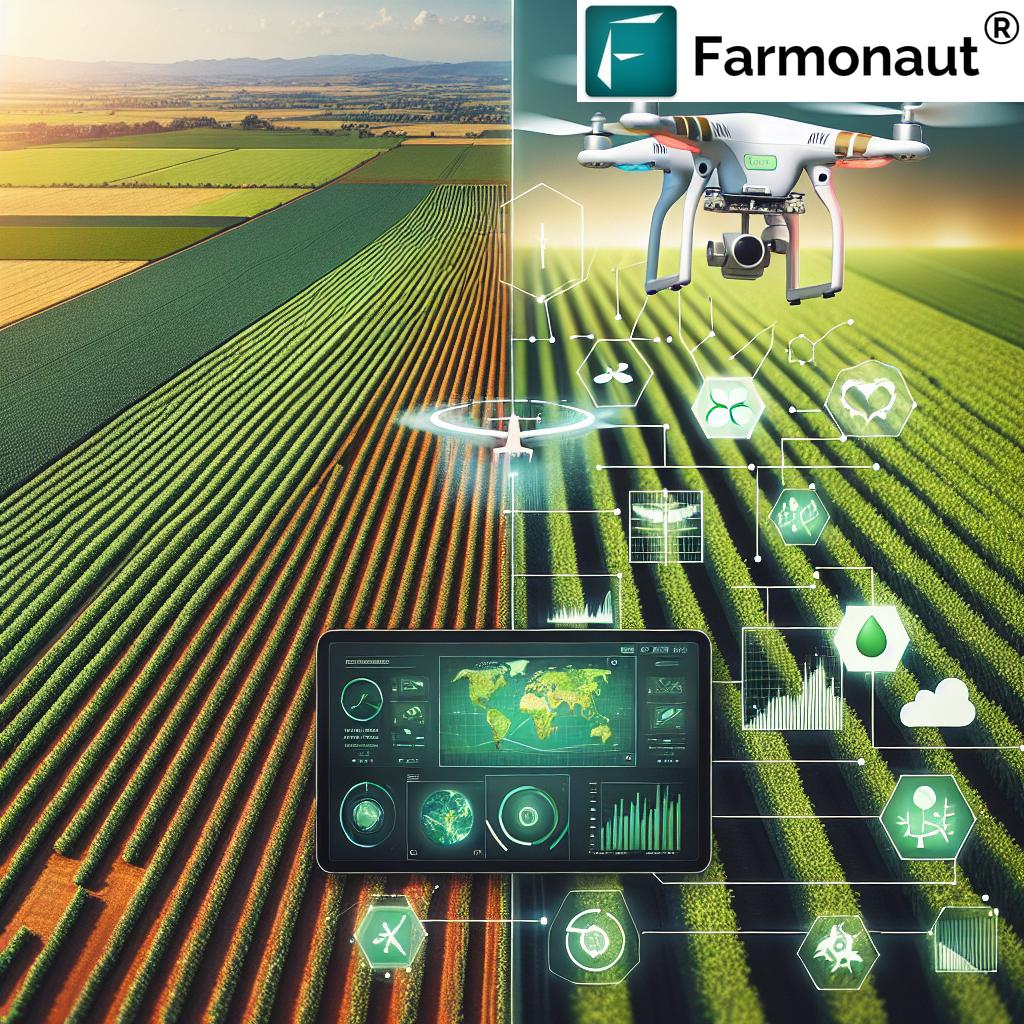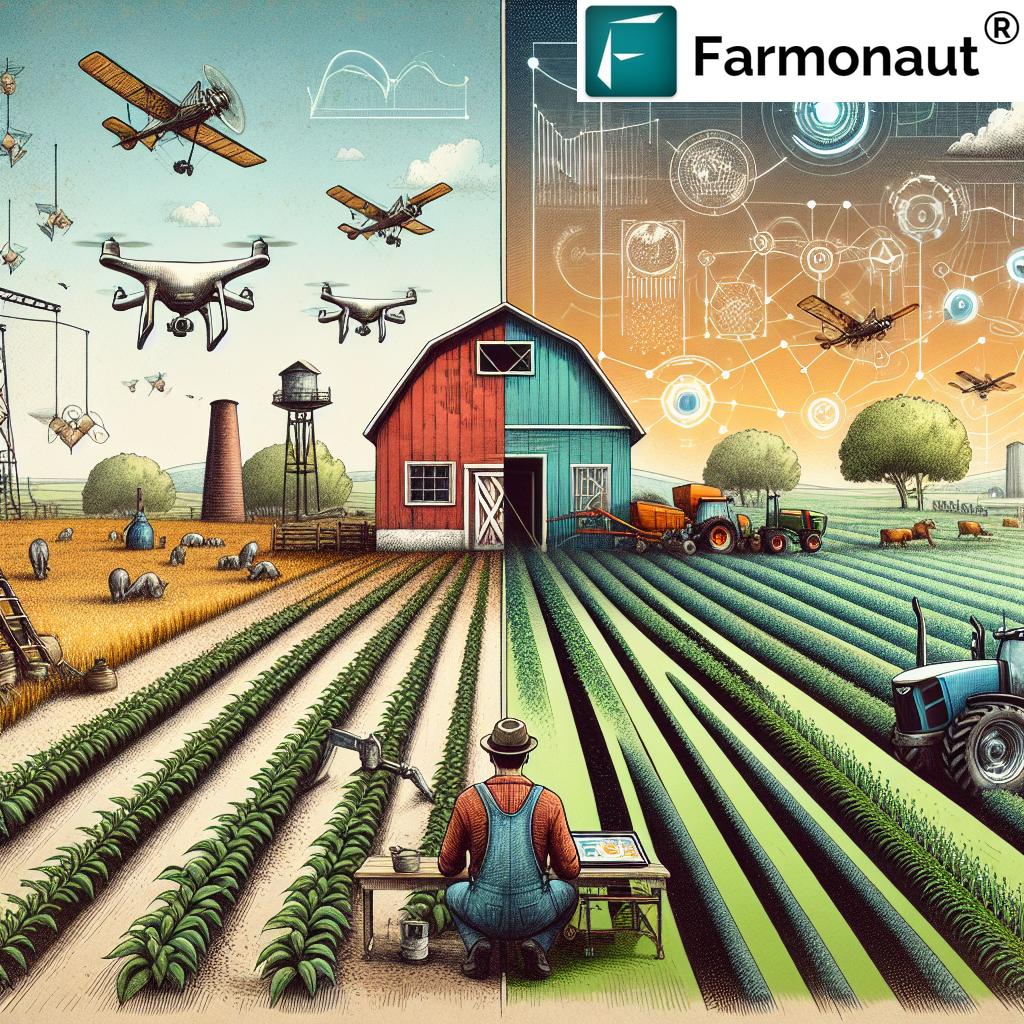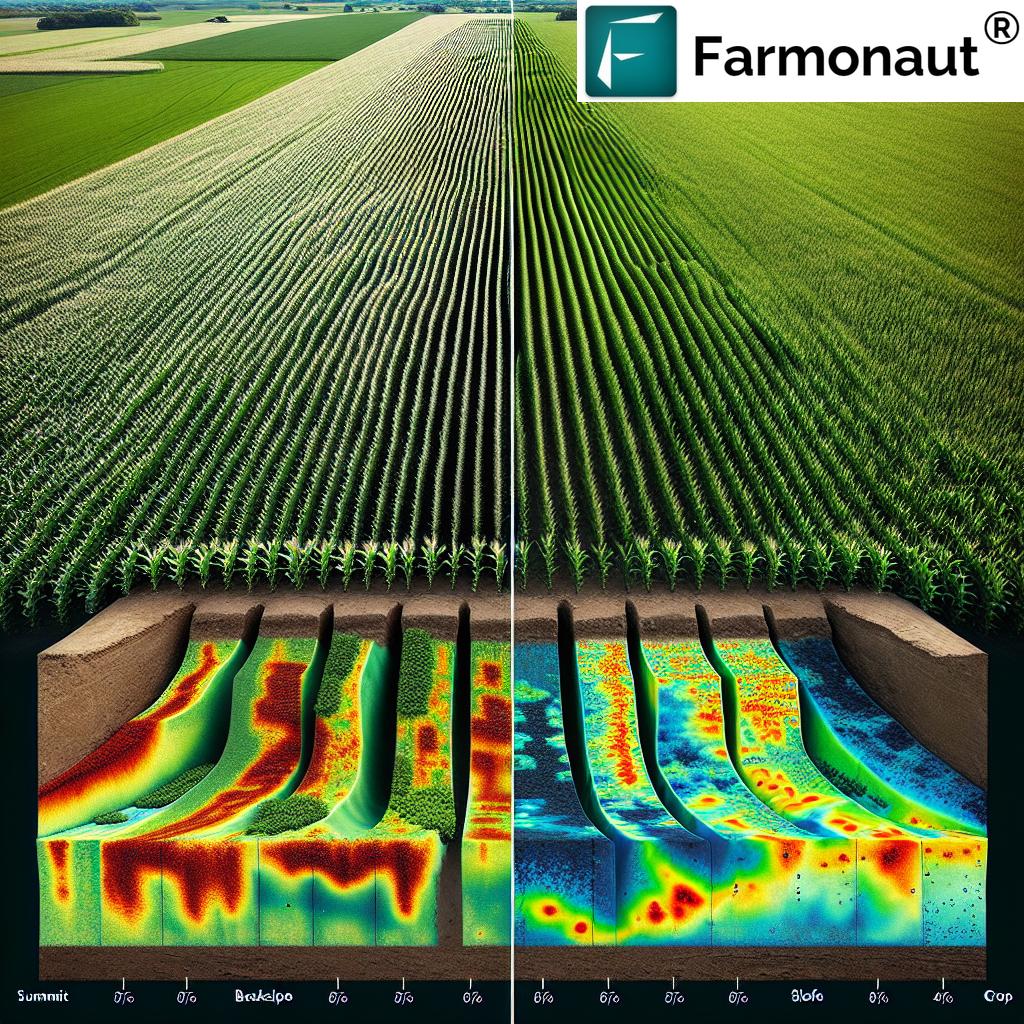Revolutionizing Agriculture: How Digital Farming and Climate Data Science Drive Sustainable Crop Production
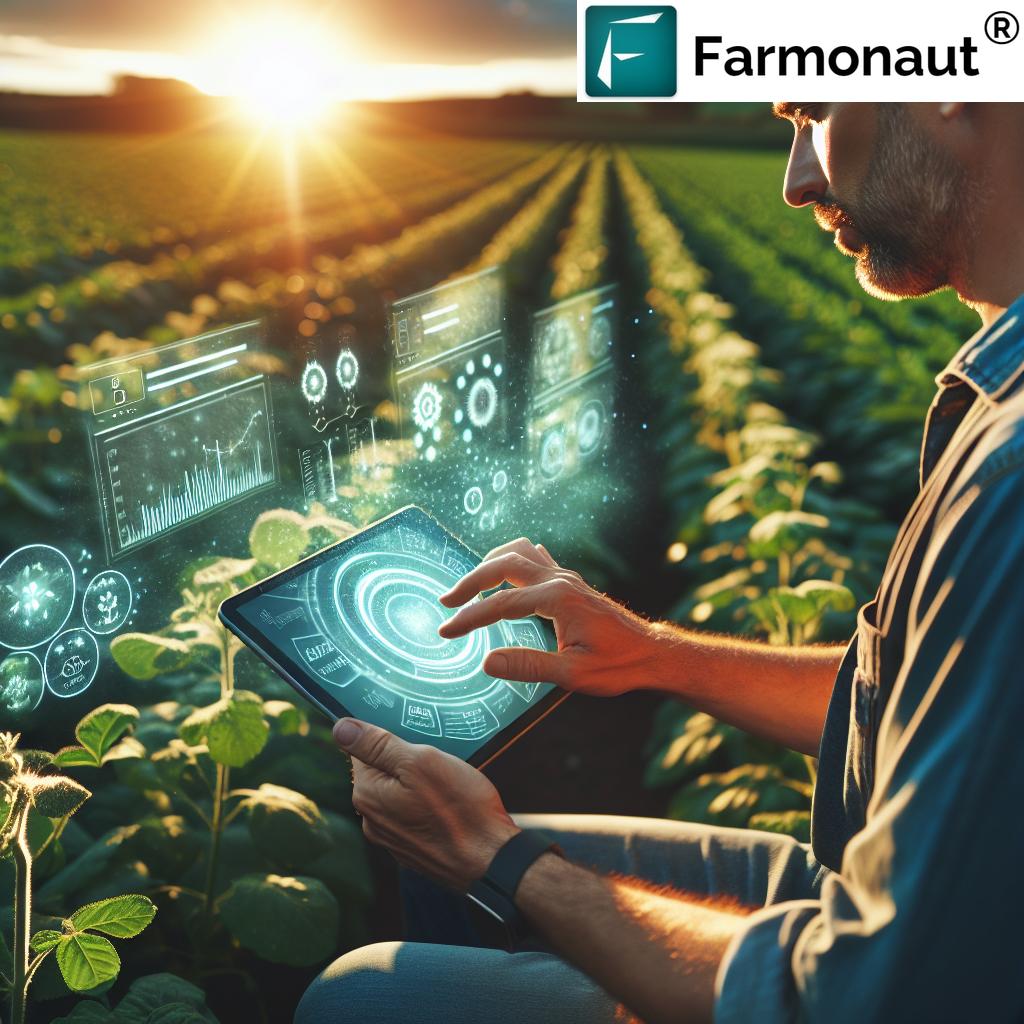
In today’s rapidly evolving agricultural landscape, we at Farmonaut are at the forefront of a digital revolution that is transforming the way farmers approach crop production. By harnessing the power of climate data science and innovative digital farming technologies, we are paving the way for more sustainable and efficient agricultural practices. This blog post delves into how these cutting-edge solutions are reshaping the future of farming, enhancing crop yields, and promoting environmental conservation.
The Convergence of Climate Data Science and Digital Farming
Climate data science has emerged as a critical tool in modern agriculture. By analyzing vast amounts of weather and climate information, we can provide farmers with unprecedented insights into environmental conditions affecting their crops. This data-driven approach allows for more precise decision-making in various aspects of farm management:
- Optimal sowing times based on climate predictions
- Irrigation scheduling aligned with rainfall patterns
- Pest and disease risk assessment linked to temperature and humidity forecasts
- Crop variety selection suited to local climate trends
Digital farming, on the other hand, encompasses a wide range of technologies that bring precision and efficiency to agricultural operations. These include:
- Satellite imagery for crop health monitoring
- IoT sensors for real-time field data collection
- AI and machine learning for predictive modeling
- Mobile apps for on-the-go farm management
At Farmonaut, we’ve integrated these two powerful domains to create a comprehensive platform that empowers farmers with data-driven insights and cutting-edge digital tools.
The Farmonaut Advantage: A Comparative Analysis
To illustrate the transformative impact of our digital farming solutions, let’s compare traditional farming methods with Farmonaut’s innovative approach:
| Feature | Traditional Farming | Farmonaut’s Solution |
|---|---|---|
| Crop Monitoring | Manual field inspections, time-consuming and labor-intensive | Satellite-based remote sensing for real-time crop health assessment |
| Weather Forecasting | Reliance on general regional forecasts | Field-specific weather predictions using advanced climate models |
| Soil Analysis | Periodic soil testing with long turnaround times | Continuous soil health monitoring through satellite and sensor data |
| Yield Prediction | Based on historical averages and farmer experience | AI-driven yield forecasting using multiple data points and machine learning |
| Pest Management | Reactive approach based on visible signs of infestation | Proactive pest risk assessment using climate data and crop stress indicators |
This comparison clearly demonstrates how Farmonaut’s digital farming platform enhances decision-making, sustainability, and productivity in agriculture.
Harnessing Satellite Technology for Precision Agriculture
One of the cornerstones of our digital farming approach is the use of satellite imagery. This technology allows us to monitor vast agricultural areas with unprecedented accuracy and frequency. Here’s how satellite-based crop monitoring is revolutionizing farming practices:
- Vegetation Health Index (NDVI): We use multispectral satellite images to calculate the Normalized Difference Vegetation Index, providing farmers with a clear picture of crop health across their fields.
- Soil Moisture Analysis: Satellite data helps us estimate soil moisture levels, enabling more efficient irrigation management.
- Crop Stress Detection: Early identification of crop stress due to pests, diseases, or nutrient deficiencies allows for timely interventions.
- Yield Estimation: By analyzing crop growth patterns over time, we can provide accurate yield predictions to help farmers plan their harvests and market strategies.
Our satellite-based solutions are accessible through our user-friendly Android and iOS apps, putting the power of precision agriculture in the palm of farmers’ hands.
Climate-Smart Agriculture: Adapting to a Changing World
As climate change continues to pose significant challenges to agriculture, our platform integrates climate data science to help farmers adapt and thrive. Here’s how we’re promoting climate-smart agriculture:
- Climate Risk Assessment: We analyze long-term climate trends to help farmers understand and prepare for potential risks to their crops.
- Adaptive Crop Selection: Our platform recommends crop varieties and cultivation practices best suited to changing local climate conditions.
- Resource Optimization: By providing precise data on water needs and nutrient requirements, we help farmers conserve resources and reduce their environmental impact.
- Carbon Footprint Tracking: We offer tools to monitor and reduce greenhouse gas emissions associated with farming activities, promoting more sustainable practices.

The Role of AI and Machine Learning in Modern Agriculture
Artificial Intelligence (AI) and Machine Learning (ML) are integral components of our digital farming platform. These technologies enable us to process vast amounts of data and generate actionable insights for farmers. Some key applications include:
- Predictive Modeling: Our AI algorithms analyze historical data, current conditions, and future projections to forecast crop yields, pest outbreaks, and optimal harvest times.
- Image Recognition: Machine learning models help interpret satellite imagery, identifying crop types, detecting anomalies, and assessing plant health with high accuracy.
- Personalized Recommendations: By learning from individual farm data over time, our system provides tailored advice on everything from fertilizer application to crop rotation strategies.
- Automated Decision Support: AI-powered alerts notify farmers of critical issues or opportunities, enabling timely interventions and optimized resource allocation.
These AI and ML capabilities are continuously evolving, making our platform more intelligent and valuable with each growing season.
Enhancing Connectivity and Data Accessibility in Rural Areas
One of the challenges in implementing digital farming solutions is the limited connectivity in many rural areas. At Farmonaut, we’ve developed strategies to overcome this hurdle:
- Offline Functionality: Our mobile app includes offline modes that allow farmers to access critical information even without an internet connection.
- Low-Bandwidth Optimized: We’ve designed our systems to work efficiently with limited bandwidth, ensuring that even farmers in remote areas can benefit from our digital tools.
- Data Compression Techniques: Advanced compression algorithms reduce the data load while maintaining the quality of satellite imagery and other crucial information.
- Local Data Caching: Important data is stored locally on devices, reducing the need for constant internet access while in the field.
By addressing connectivity challenges, we’re ensuring that the benefits of digital farming are accessible to farmers across diverse geographical regions.
Integrating Weather Data for Precise Agricultural Planning
Accurate weather forecasting is crucial for successful farming, and our platform leverages advanced meteorological data to provide farmers with precise, field-specific weather information. Here’s how we’re integrating weather data into our digital farming solutions:
- Hyperlocal Forecasts: We provide highly localized weather predictions, taking into account microclimates and topographical features that can affect individual fields.
- Historical Weather Analysis: By analyzing long-term weather patterns, we help farmers make informed decisions about crop selection and planting times.
- Extreme Weather Alerts: Our system sends timely notifications about impending extreme weather events, allowing farmers to take preventive measures to protect their crops.
- Weather-Based Recommendations: We offer tailored advice on irrigation, pest control, and harvesting based on current and forecasted weather conditions.
This integration of detailed weather data enables farmers to optimize their operations and mitigate weather-related risks effectively.
Soil Health Monitoring and Management
Healthy soil is the foundation of productive agriculture, and our digital farming platform places a strong emphasis on soil health monitoring and management. Here’s how we’re helping farmers maintain and improve their soil quality:
- Remote Soil Analysis: Using satellite imagery and spectral analysis, we can assess various soil properties without the need for frequent physical sampling.
- Nutrient Mapping: Our platform generates detailed maps of nutrient distribution across fields, enabling precise and targeted fertilizer application.
- Erosion Risk Assessment: By analyzing topography and rainfall patterns, we identify areas at risk of soil erosion and suggest conservation measures.
- Organic Matter Tracking: We monitor changes in soil organic matter content over time, helping farmers implement practices that enhance soil fertility and carbon sequestration.
By providing these insights, we empower farmers to adopt sustainable soil management practices that improve crop yields while preserving this vital resource for future generations.
Optimizing Resource Use in Agriculture
Efficient resource management is crucial for sustainable agriculture, and our digital farming platform offers various tools to help farmers optimize their use of water, fertilizers, and other inputs:
- Smart Irrigation Scheduling: By combining soil moisture data, weather forecasts, and crop water requirements, we provide precise irrigation recommendations to conserve water while ensuring optimal plant growth.
- Variable Rate Application: Our platform generates prescription maps for variable rate application of fertilizers and pesticides, reducing waste and minimizing environmental impact.
- Energy Efficiency Tracking: We help farmers monitor and reduce energy consumption in their operations, from machinery use to storage facilities.
- Waste Reduction Strategies: Our system identifies opportunities to minimize agricultural waste and suggests ways to repurpose or recycle byproducts.
These resource optimization tools not only improve farm profitability but also contribute to more sustainable agricultural practices.
Enhancing Crop Yield and Quality Through Data-Driven Decisions
At the heart of our digital farming platform is the goal of improving crop yields and quality. We achieve this through a combination of data analysis, predictive modeling, and personalized recommendations:
- Yield Potential Mapping: By analyzing historical yield data, soil conditions, and environmental factors, we create maps that show the yield potential across different areas of a field.
- Crop Stress Detection: Our satellite imagery analysis can detect early signs of crop stress, allowing for timely interventions to prevent yield loss.
- Quality Parameter Tracking: We monitor various factors that influence crop quality, such as sugar content in fruits or protein levels in grains, helping farmers optimize their production for market demands.
- Harvest Timing Optimization: Our platform provides recommendations on the optimal time to harvest based on crop maturity, weather forecasts, and market conditions.
By leveraging these data-driven insights, farmers can make informed decisions that lead to improved crop performance and higher-quality harvests.
Integrating Digital Farming with Sustainable Practices
Sustainability is a key focus of our digital farming solutions. We believe that technology can play a crucial role in promoting environmentally friendly agricultural practices:
- Conservation Agriculture Support: Our platform provides guidance on implementing conservation agriculture techniques, such as minimal tillage and crop rotation, to improve soil health and reduce erosion.
- Biodiversity Monitoring: We use satellite imagery to track changes in on-farm biodiversity, helping farmers maintain ecological balance in their fields.
- Carbon Sequestration Tracking: Our system estimates the carbon sequestration potential of different farming practices, encouraging methods that increase soil organic matter and reduce greenhouse gas emissions.
- Integrated Pest Management (IPM): We provide data-driven support for IPM strategies, reducing reliance on chemical pesticides and promoting natural pest control methods.
By integrating these sustainable practices into our digital farming platform, we’re helping farmers reduce their environmental impact while maintaining productive and profitable operations.
The Future of Digital Farming: Emerging Technologies and Trends
As we continue to innovate in the field of digital farming, we’re exploring and integrating several emerging technologies that promise to further revolutionize agriculture:
- Internet of Things (IoT) Integration: We’re working on seamless integration with IoT devices such as soil sensors, weather stations, and smart machinery to provide even more detailed and real-time data.
- Blockchain for Traceability: Implementing blockchain technology to enhance food traceability and transparency in the supply chain.
- Advanced Drone Technology: Exploring the use of drones for ultra-high-resolution imagery and even targeted applications of inputs.
- Edge Computing: Developing edge computing solutions to process data locally on farms, reducing latency and improving real-time decision-making capabilities.
- 5G Connectivity: Preparing our platform to leverage 5G networks for faster data transmission and more responsive digital farming applications.
These emerging technologies will enable us to provide even more powerful and efficient digital farming solutions in the future.
Empowering Farmers Through Education and Support
At Farmonaut, we believe that technology is only as effective as the farmers’ ability to use it. That’s why we’re committed to providing comprehensive education and support to our users:
- In-App Tutorials: Our mobile app includes interactive tutorials that guide farmers through the various features and tools available.
- Webinars and Online Courses: We offer regular webinars and online courses on topics ranging from basic digital farming concepts to advanced data analysis techniques.
- Community Forums: Our platform includes community forums where farmers can share experiences, ask questions, and learn from each other.
- Personalized Support: Our team of agricultural experts is available to provide personalized support and advice to farmers using our platform.
- Continuous Learning Resources: We regularly update our knowledge base with the latest research and best practices in digital farming.
By providing these educational resources and support systems, we ensure that farmers can fully leverage the power of our digital farming platform to improve their operations.
Customizable Solutions for Diverse Agricultural Needs
We recognize that every farm is unique, with its own set of challenges and requirements. That’s why our digital farming platform is designed to be highly customizable:
- Crop-Specific Modules: We offer specialized modules for various crops, from grains and vegetables to fruits and specialty crops.
- Scalable Solutions: Our platform can be tailored to meet the needs of small family farms as well as large commercial operations.
- Integration with Existing Systems: We provide APIs and integration tools to connect our platform with other farm management software and hardware.
- Customizable Alerts and Reports: Farmers can set up personalized alerts and generate custom reports based on their specific interests and priorities.
- Language and Regional Settings: Our platform supports multiple languages and can be adjusted to account for regional agricultural practices and regulations.
This flexibility ensures that our digital farming solutions can be adapted to meet the diverse needs of farmers around the world.
Collaborative Research and Development
To stay at the forefront of agricultural innovation, we actively engage in collaborative research and development initiatives:
- Partnerships with Universities: We collaborate with leading agricultural universities to conduct field trials and validate our digital farming models.
- Industry Collaborations: We work with other agtech companies to develop integrated solutions that address complex farming challenges.
- Government Research Programs: We participate in government-funded research programs aimed at advancing sustainable agriculture through technology.
- Open Data Initiatives: We contribute to and benefit from open data projects in agriculture, fostering a collaborative approach to solving global farming challenges.
These collaborative efforts ensure that our digital farming platform continues to evolve and incorporate the latest scientific advancements and industry best practices.
Frequently Asked Questions (FAQ)
-
Q: How does Farmonaut’s digital farming platform improve crop yields?
A: Our platform uses satellite imagery, weather data, and AI-driven analytics to provide farmers with actionable insights on crop health, optimal resource use, and potential risks. This allows for timely interventions and better decision-making, leading to improved yields. -
Q: Is Farmonaut’s solution suitable for small-scale farmers?
A: Yes, our platform is designed to be accessible and beneficial for farmers of all scales. We offer affordable pricing tiers and user-friendly interfaces that make digital farming technologies available to small-scale farmers. -
Q: How accurate is the satellite-based crop monitoring?
A: Our satellite-based crop monitoring is highly accurate, with resolution capabilities down to 3 meters. We use multiple satellite sources and advanced image processing techniques to ensure reliable and timely information. -
Q: Can Farmonaut’s platform work in areas with limited internet connectivity?
A: Yes, we’ve designed our mobile app with offline functionality and low-bandwidth optimization to ensure that farmers in areas with limited connectivity can still benefit from our digital farming tools. -
Q: How does Farmonaut contribute to sustainable agriculture?
A: Our platform promotes sustainability by optimizing resource use, reducing chemical inputs through precision application, supporting conservation practices, and helping farmers adapt to climate change through data-driven decision-making.
Conclusion: Embracing the Digital Farming Revolution
As we’ve explored throughout this blog post, digital farming, powered by climate data science and innovative technologies, is transforming agriculture in profound ways. At Farmonaut, we’re proud to be at the forefront of this revolution, providing farmers with the tools and insights they need to increase productivity, enhance sustainability, and adapt to a changing climate.
By harnessing the power of satellite imagery, AI, machine learning, and advanced weather modeling, we’re enabling farmers to make more informed decisions, optimize their resources, and produce higher quality crops while minimizing environmental impact. Our commitment to continuous innovation, user education, and collaborative research ensures that we’ll continue to evolve our platform to meet the ever-changing needs of the agricultural sector.
We invite farmers, agronomists, and agricultural stakeholders to join us in embracing this digital farming revolution. Together, we can build a more sustainable, productive, and resilient future for agriculture.
To experience the power of our digital farming platform firsthand, visit our website or download our mobile app today:
For developers interested in integrating our satellite and weather data into their own applications, check out our API documentation.
Ready to start your digital farming journey? Subscribe to Farmonaut today:
Join us in shaping the future of agriculture – where data-driven insights meet sustainable practices for a more productive and resilient farming ecosystem.




